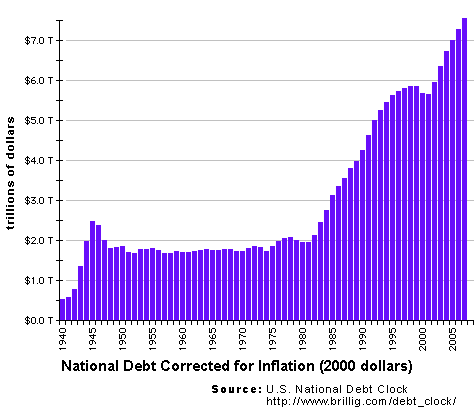Q: What is the difference between the Debt and the Deficit?
A: The National Debt is the total amount of money owed by the government; the federal budget deficit is the yearly amount by which spending exceeds revenue. Add up all the deficits (and subtract those few budget surpluses we've had) for the past 200+ years and you'll get the current National Debt.
Politicians love to crow "The deficit is down! The deficit is down!" like it's a great accomplishment. Don't be fooled. Reducing the deficit just means we're adding less to the Debt this year than we did last year. Big deal -- we're still adding to the Debt. When are we going to start seeing the Debt actually go down?
Q: How has the National Debt grown over time?
A: The National Debt on January 1st 1791 was just $75 million dollars. Today, it rises by that amount every hour or so.
The following graph shows how the National Debt has grown year by year since 1940 in actual dollar amounts, uncorrected for inflation:
US National Debt from 1940 to Present
This data was gathered from the U.S. Treasury department's web site.
From time to time, I've gotten e-mail saying that the above graph is flawed -- it's just showing normal inflation. Well, I took the Debt numbers from the above graph and converted them all to 2000 dollars. Picking a different year would not have changed the shape of the graph below, just its height:
US National Debt, corrected for inflation (2000 dollars)
As you can see, except for a rise at the end of World War II, the Debt remained remarkably constant for nearly forty years when inflationary forces are taken into account. After 1983 however, with the notable exception of the Fiscal Years ending in September of 2000 and 2001, the trend has been upward even when inflation is taken into account.
Q: To whom do we owe all this money? Who owns the Debt?
A: Here is a pie chart showing the makeup, or ownership, of the National Debt as of December 1998.
Ownership of the National Debt
As you can see, the largest slice of the pie, over 40%, is owed to the Federal Reserve Bank and to other government accounts; that is, this part of the Debt is owed by one part of the government to another. The remaining 60% of the Debt, roughly $3.3 trillion, is privately held.
The above information is from the June 1999 issue of the "Treasury Bulletin", a quarterly publication of the U.S. Treasury department's Financial Management Service. The Treasury Bulletin is the best place to find the latest information on this subject.
The Public Debt to the Penny and Who Holds It




By the way, if you want to stop these spammers, you can set up your blog to do a "word verification" for posters. It should stop the spam.
ReplyDelete